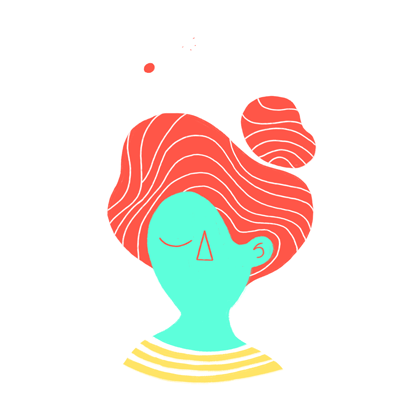French illustrator and animator Emilie Muszczak thrives on bright colors, quirky patterns, and tea. Most of her work begins as a happy mess of doodles, words, and colors in her notebook. See how she created an animated self-portrait using Adobe Photoshop and Animate to represent the way her brain generates the random thoughts that become future projects.
Paint the portrait
Emilie imports a scanned (outline) self-portrait into Photoshop. On a separate layer, she adds circles of yellow, cyan, and orange to the canvas to keep her color palette within easy reach while she uses a Spatter Brush at varying sizes to paint different parts of the portrait.


Emilie creates separate layers for the head, hair, face, and shirt, and adjusts her brush size as needed to paint each part. Emilie creates a clipping mask over the hair layer, then paints with a white, narrow brush to trace wavy lines throughout the hair. When she’s done painting, Emilie hides the color palette and sketch layers before saving the image as a JPEG file.


Animate the bubbles
Emilie switches to Animate to create a series of animated bubbles floating up from her head. She creates an HTML5 Canvas document and imports the JPEG of her self-portrait as its own layer on the timeline. Then, she clicks on keyframe 49 in the timeline and inserts a blank keyframe (Insert > Timeline > Blank Keyframe) so the overall animation lasts just under a minute.
Next, Emilie meticulously draws and animates four separate bubble sequences. She creates a new layer for Bubble 1, then uses a thin brush to draw a small arc that starts the formation of the bubble. She adds another blank keyframe so this part of the animation lasts two frames.


She continues to draw different stages of the bubble forming, reaching its maximum size, breaking away, and then popping. At each stage of the bubble’s lifespan, she sets the animation to last two frames until the animated sequence is complete and the bubble pops. She repeats this process to create three more bubble sequences.


Emilie then exports the sequences so she can finish her work in Photoshop. She exports the Bubble 1 sequence first. To do so, she hides all the layers in the timeline except Bubble 1. Then, she chooses File > Export > Export Movie, selects PNG sequence, and saves the sequence to its own folder on her computer. She repeats this process to create the PNG sequence for the remaining bubble animations.
Perfect the bubble animation
Back in Photoshop, Emilie finesses the appearance and timing of the bubbles. She imports each bubble sequence she generated from Animate (by choosing File > Open, then selecting Image Sequence from the Options dialog box), and positions it where she wants it in the portrait. Then in the timeline (Windows > Timeline), she moves the sequences around so they start and stop at different times to mimic the random nature of bubbles.


Emilie spends most of her time tracing and filling each stage of the bubble’s lifespan. She starts with the first bubble sequence, adds a layer, and fills the bubble using an orange brush. Then, she moves slightly ahead on the timeline to the next stage of the bubble, adds a layer, and fills the next formation. She repeats this for each formation of the bubble on all four sequences. When she’s done, each bubble stream may require a range of 30–60 layers to complete the sequence, and each layer spans two seconds on the timeline.


Add subtle motion to the portrait
Emilie adds subtle animation to the face, head, hair, hair lines, and shirt. Starting with the face, she adds a new layer and traces the facial features. She repeats this process to create four more layers of the face. Since each new layer is drawn with slight variations, the result creates a shimmering, hand-drawn effect when animated.
Emilie then duplicates the five layers of the face within the timeline enough times to fill the length of the animated sequence. Each layer spans two seconds.
Emilie repeats the process for the head, hair, hair lines, and shirt — traces the outline, fills with color, duplicates layers, spans the timeline — so that each part of the portrait has its own animation.


Export as an animated GIF
When she’s finished with her portrait, Emilie chooses File > Export > Save for web (legacy), selects GIF, and sets it to loop forever.


See Emilie’s animated self-portrait in action.


About the artist
Emilie Muszczak is inspired by just about every type of art form. She has studied and practiced graphic, spatial, and fashion design. She’s done painting, modeling, sculpting, and life drawing, and has a master’s degree in 3D animation. Growing up in France, Emilie had no shortage of opportunities to be surrounded by art culture and education. But, it also made for a competitive field when she was trying to make a living as an artist. Eventually, she landed a job half a world away, and now works for a design animation studio in Toronto.
In Toronto, she’s in her element. It’s a city of cultures, colors, and tastes, where Emilie discovers new things every day. Emilie starts every project with a cup of tea before brainstorming. Whether at school, at work, on a walk, or almost asleep, Emilie has a sketchbook handy to capture ideas.
Emilie does her best work in brightly colored, collaborative environments. When she settles on an idea she likes, she scans her drawing so she can refine it on her computer. She experiments with colors, textures, and patterns, and then spends a lot of time finessing the drawing and animation.